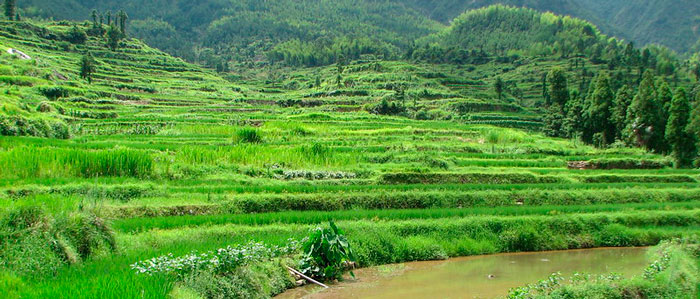Rice Fish Culture, China
GIAHS since 2011

Site location: China: Qintian county in Zhejiang province; Congjiang county in Guizhou province.
Area of GIAHS: 460 ha
Population working for this system: -
Topological Characteristics: -
Climatic Classification: -
Ethnic Groups/Indigenous People: Han and other minorities like Mong
Primary Income Sources: agriculture, work abroad
------------------------------------------------------------------------------------
Global importance
Rice-Fish System is an ingenious practice which is able to generate economic and social benefits for local community through encouraging essential ecological functions and provision of multiple goods and services. Rice–Fish system ensures food security (rice production), quality nutrition and income generation (consumption and sale of fish), prevention of malaria (reducing mosquito by fish), conservation of biodiversity (rice, fish and associated species due to reduction of pesticides), pest regulation and the establishment of carbon and nutrient cycles. The system can reduce pesticides and fertilizers application, which are threatening human health, other species and the environment.
However, rice-fish lands have decreased from 1532 thousand hectares in 2000 to 1480 thousand hectors in 2002. The rice-fish farming system is threatened by expansion of highly productive mono rice or fish systems, which include improved rice or fish varieties with excessive application of chemicals (especially pesticides for rice and antibiotic medicines for fish) in rice fields or fish ponds.
Food and livelihood security
The major agricultural products in Longxian village are rice, fish and tea. Although the per capita land in the village is only 0.44 hectares, each farmer grows rice and raises fish in their rice fields. Besides agriculture, off-farm activities, such as stone carving and tourism are supporting farmers' livelihoods in the village. Cash needs are mainly catered for through remittances by village members that have migrated to western countries.
Although cultivating fish reduces the area available for planting rice, the integrated system lead to higher returns than those of rice monoculture. This is due to the fact that within the rice-fish system, the rice yield is higher, the farmers receive an additional income from the fish sales and in most of the cases they save on fertilizers and pesticides. Generally, fish yields are 300-450 kg/ha and with maximum yields of over 1,500 kg/ha.
Biodiversity and ecosystem functions
Agricultural biodiversity of the Rice-Fish system includes forest species (70% of the water catchments), traditional rice varieties (20 native rice varieties – many threatened), plant species for home gardens, and livestock/poultry breeds. Concerning the fishes, 6 native breeds of carp red, black, white and variegated are grown up within the system.
The ecosystem function of the Rice-Fish system is well evident, including the integrated use of forest (70% of water catchment) and managed rice-fish interactions for nutrient recycling, pest control and high quality protein production from organic waste material; use of 4 species of Azolla for nitrogen fixation and protein rich fish food and use of trees in field and hedges for pest control (ethno-pesticides or habitats for beneficial insects).
Knowledge systems and adapted technologies
Rice-Fish System is an aquaculture system that integrates growing fish in flooded paddy fields. The combination of rice and fish is highly managed with the construction of ditches, furrows or ponds with appropriate level of water to host fish when conditions in the rice fields are not suitable to fish. Rice growth releases oxygen to the air. The shallow water in rice fields brings much water in contact with the air. The disturbance by fish activities also helps maintain oxygen solution in the water for fish growth.
Rice and fish can be combined with other beneficial plants. The intercropping of different rice varieties in the rice fields could reduce significantly the incidence of rice diseases and needs of pesticides. This practice has helped to restore fish culture in the rice fields where the application of pesticides used to be a major threat to fish.
Cultures, value systems and social organizations
The Rice-Fish system is described not only as one of production style, but also as one of the culture. In the tombs of the mid-Eastern Han Dynasty (25-220 AD), two clay models were unearthed: a model of a pond and a model of a rice field. The pond model contained 15 miniature pieces (6 common carp, 1 soft-shell turtle, 3 frogs, and 5 water chestnuts).
Cultural activities like traditional rice-fish dance and traditional dishes are the results of the Rice-Fish system. As rice fields in China are small, farmers’ cooperation in the village is essential to managing this rice-fish culture. In some cases, rice growers and fish growers cooperate in using same rice fields for production.
Remarkable landscapes, land and water resources management features
Rice fish systems have shaped the landscapes with its living paddies where the forest surrounds the fields. In terms of the land and water management, a larger ingenious water management system is maintaining where the farmers is self-organized to maintain canals, ditches and ponds.

